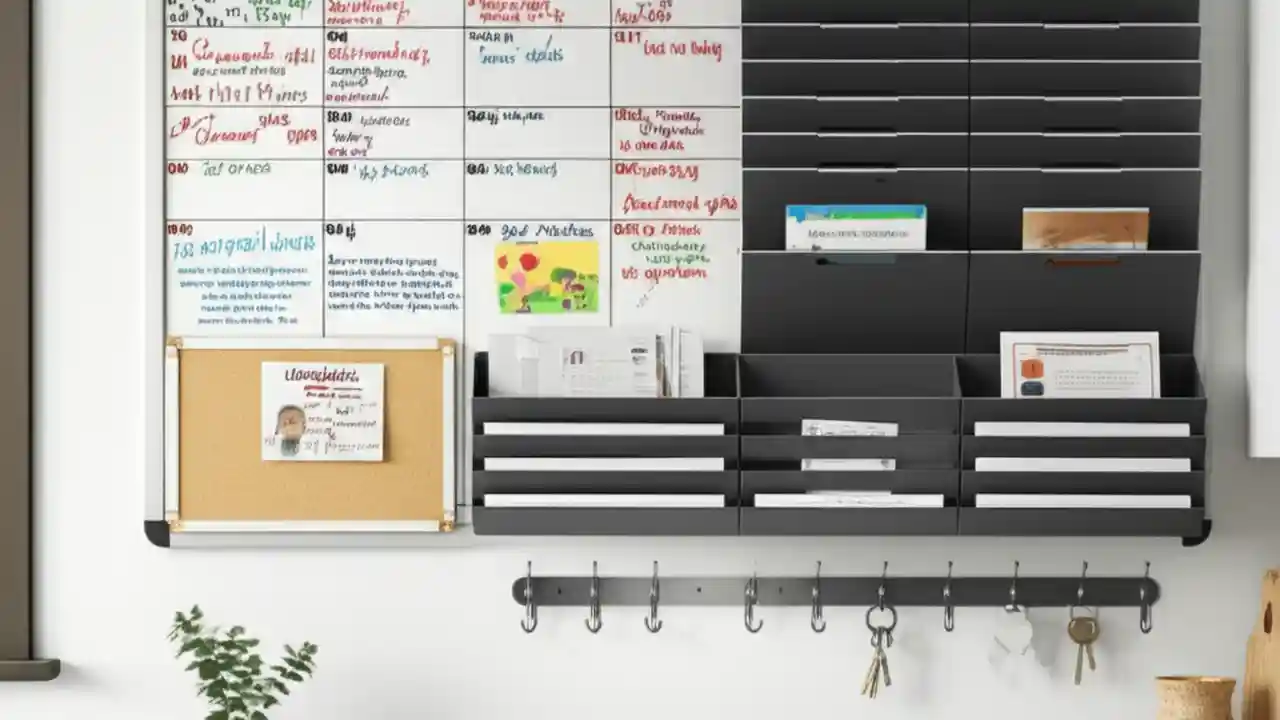A weekly planning session is the single most powerful habit for transforming chaos into clarity, dramatically reducing stress while boosting your productivity. It’s your dedicated time to step back, review your progress, and intentionally design the week ahead, ensuring your daily actions align with your most important long-term goals. This isn’t just about making a to-do list; it’s about strategic foresight.
For over two decades, I’ve guided everyone from startup founders to seasoned executives, and the pattern is undeniable: those who consistently implement a weekly review and planning session are the ones who feel in control and achieve exceptional results. They trade reactive firefighting for proactive execution. It’s the difference between being a passenger in your own life and firmly holding the steering wheel.
In this definitive guide, we’ll go far beyond the surface-level benefits. We’ll explore the psychological relief it provides, offer a step-by-step framework for your first session, compare the best tools for the job, and troubleshoot the common pitfalls that stop most people. By the end, you’ll have a complete blueprint for making this your cornerstone productivity habit.
Table of Contents
The “Why”: Unpacking the Core Benefits of Weekly Planning
Before we get into the “how,” let’s solidify the “why.” Understanding the profound impact a weekly planning session can have on your professional and personal life is the motivation you’ll need to make it a non-negotiable part of your routine. It’s more than just getting organized; it’s about fundamentally changing your relationship with time.
How does a weekly plan reduce anxiety and overwhelm?
The feeling of overwhelm doesn’t come from having too much to do. It comes from not knowing what to do next, or the nagging suspicion that you’re forgetting something important. This creates a state of constant, low-grade anxiety. A weekly planning session acts as a “brain dump,” externalizing all your tasks, commitments, and ideas from your head into a trusted system.
This process, inspired by David Allen’s “Getting Things Done” methodology, frees up mental RAM. Instead of your brain trying to juggle dozens of open loops, it can focus on the task at hand. You create a clear map for the week, which provides a powerful sense of control. When you know that everything important has been captured and scheduled, the anxiety subsides. You trust your system, not your memory.
What are the top 5 tangible benefits of weekly planning?
While the benefits are numerous, they can be distilled into five critical areas that you will notice almost immediately after you begin this practice.
- Increased Proactivity, Decreased Reactivity: You start the week with a clear intention. Instead of opening your email and letting other people’s priorities dictate your day, you work from your own pre-defined plan. You’re playing offense, not defense.
- Better Alignment with Goals: It’s easy to get lost in the “busywork” of daily life. A weekly session forces you to ask, “Does this activity move me closer to my quarterly or annual goals?” It ensures your short-term efforts are building toward your long-term vision.
- Enhanced Decision-Making: When a new opportunity or request comes in mid-week, you can evaluate it against your planned priorities. It becomes easier to say “no” to distractions and “yes” to things that truly matter, because you have a clear context for your decisions.
- Improved Work-Life Balance: Effective planning isn’t just about work. It’s about intentionally scheduling time for family, health, hobbies, and rest. By allocating specific blocks for personal priorities, you protect them from being squeezed out by professional demands.
- Compounding Progress: Each weekly session builds on the last. The review part of the process allows you to learn what worked and what didn’t, so you can make small adjustments. Over months and years, these tiny course corrections lead to massive, compounding growth.
Can weekly planning really improve work-life balance?
Absolutely. In fact, it’s one of its most underrated superpowers. Many people think of “work-life balance” as something that just happens. The truth is, it has to be designed. Without a plan, work has a natural tendency to expand to fill all available time. This is known as Parkinson’s Law.
During your weekly planning, you act as the architect of your entire life, not just your job. You can proactively block out “non-negotiables” first. For example:
- Gym sessions on Monday, Wednesday, Friday at 6 PM.
- Date night every Thursday.
- Reading time from 9:30 PM to 10 PM every night.
- “Deep work” block for a passion project on Saturday morning.
By putting these personal appointments on your calendar with the same seriousness as a client meeting, you create a structure that forces work to fit into the remaining time. This is a game-changer for preventing burnout and ensuring you’re nurturing all aspects of your life.
Getting Started: Your First Weekly Planning Session
The idea can seem intimidating, but the process is simple. The key is to start small and build consistency. Don’t aim for a perfect, multi-hour session on your first try. A focused 30-minute session is far better than nothing.
How do I conduct my first weekly planning session? A step-by-step guide.
Find a quiet time and place where you won’t be interrupted. For many, Sunday evening is ideal as it sets the stage for the week, but a Monday morning can also work well to kick things off. Grab your tools (a notebook or an app) and follow these steps.
- Step 1: The Brain Dump (10 minutes). Write down everything on your mind. Tasks, worries, ideas, appointments, things you need to buy, people you need to call. Everything. Don’t organize it yet, just get it all out of your head and onto the page or screen.
- Step 2: The Past Week Review (5 minutes). Look back at last week’s calendar and to-do lists. What went well? What didn’t? What did you accomplish? What’s left over? This isn’t about judgment; it’s about learning. Acknowledge your wins.
- Step 3: Define Your “Big 3” for the Week (5 minutes). Look at your long-term goals and your brain dump list. What are the 1-3 most important things you need to accomplish this week to feel successful and make progress? These are your weekly priorities. Write them down at the top of a fresh page.
- Step 4: Schedule Your Priorities (10 minutes). Open your calendar. First, block in your non-negotiable appointments (meetings, personal commitments). Next, schedule your “Big 3.” Treat them like appointments. If a priority requires 3 hours of focused work, find a 3-hour slot and block it out as “Deep Work: Project X.”
- Step 5: Slot in the Small Stuff. Look at the remaining smaller tasks from your brain dump. Can you group them? (e.g., make all your phone calls on Tuesday afternoon). Can you delegate any? Add the essential ones to your daily to-do lists for the week or into small, open slots on your calendar.
That’s it. You now have a roadmap for the week. It won’t be perfect, but it’s a powerful start.
How long should a weekly planning session take?
The ideal duration varies, but a good target is between 30 to 60 minutes. When you’re just starting out, 30 minutes is plenty. Don’t let the perfect be the enemy of the good. The goal is consistency, not duration.
As you become more practiced, you might find you enjoy a longer, more reflective session of up to 90 minutes. Here’s a sample breakdown of how time might be allocated as you get more advanced:
| Activity | Beginner (30 Mins) | Advanced (60 Mins) |
|---|---|---|
| Clear Your Head / Brain Dump | 10 mins | 15 mins |
| Review Past Week & Metrics | 5 mins | 10 mins |
| Review Long-Term Goals | – | 5 mins |
| Set Weekly Priorities (“Big 3”) | 5 mins | 10 mins |
| Schedule Priorities & Tasks | 10 mins | 20 mins |
The key is to set a timer and stick to it. This keeps the session focused and prevents it from becoming a procrastination task in itself.
Tools and Systems: Finding What Works for You
There’s no single “best” tool for weekly planning. The best system is the one you’ll actually use consistently. The primary choice is between analog (pen and paper) and digital tools. Both have distinct advantages.
What’s the difference between a weekly plan and a daily to-do list?
This is a crucial distinction. Confusing the two is a common reason why planning efforts fail. They serve different purposes but work together beautifully.
| Aspect | Weekly Plan | Daily To-Do List |
|---|---|---|
| Altitude | Strategic (The “What” & “Why”) | Tactical (The “How” & “When”) |
| Focus | Setting priorities, allocating major time blocks, ensuring goal alignment. | Executing specific, granular tasks for a single day. |
| Example Item | “Draft the Q3 marketing report.” | “1. Research competitor data. 2. Create report outline. 3. Write first section.” |
| Creation Time | Once per week, during your planning session. | Every morning, or the evening before, based on the weekly plan. |
Think of your weekly plan as the architect’s blueprint for a house. The daily to-do list is the builder’s specific set of tasks for that day: “lay the foundation,” “frame the walls.” You need the blueprint to ensure the daily tasks build the right house.
What are the best tools for weekly planning? Digital vs. Analog.
Your choice of tool depends on your personal style, your work, and what feels most engaging to you. Let’s compare the two main approaches.
Analog (Pen & Paper):
- Pros: The physical act of writing can improve memory and focus. It’s distraction-free (no notifications!). It offers infinite flexibility—a blank notebook can become anything you want it to be. Many people, myself included, find a deep satisfaction in using a quality pen and journal.
- Cons: It can be cumbersome to carry around. It’s not easily searchable. Moving tasks or appointments requires messy scribbling or rewriting.
- Popular Choices: Bullet Journal (BuJo) method, dedicated planners like the Full Focus Planner, or a simple, high-quality notebook like a Leuchtturm1917.
Digital Tools:
- Pros: Accessible from any device. Easy to edit, move, and set recurring tasks. Integrates with your calendar, email, and other apps. Allows for collaboration and sharing.
- Cons: Can be distracting with notifications. The “infinite canvas” can sometimes be overwhelming. Some find it less personal or engaging than writing.
- Popular Choices: Todoist, Asana, Trello (for visual, board-based planning), Notion (for an all-in-one “life OS”), or simply your Google/Outlook Calendar.
My advice? Try both. Spend two weeks with a notebook and two weeks with a digital app. Pay attention to which process you enjoy more and which one leads to better results for you. There is no wrong answer.
Mastering the Habit: Advanced Tips and Troubleshooting
Once you’ve started, the next challenge is to stay consistent and refine your process. Life will inevitably throw curveballs at your perfectly crafted plans. Here’s how to handle them and make your planning habit stick.
How do I handle unexpected tasks that derail my plan?
This is the number one reality of any plan: it will be challenged. The goal of a plan isn’t to be rigid; it’s to provide a compass. When an urgent and important task appears, you have a framework to make a smart decision.
Use the “Capture, Clarify, Decide” model:
- Capture: Don’t just do it. Write it down in an “inbox” (a dedicated page in your notebook or a digital inbox). This prevents it from breaking your focus.
- Clarify: Ask yourself: Is this truly urgent AND important? Does it need to be done today? Who is the right person to do it?
- Decide: You have four options:
- Do it now: If it’s critical and takes less than 2 minutes.
- Defer it: If it’s important but not urgent, schedule it for later in the week by consciously swapping it with a lower-priority task.
- Delegate it: If you’re not the best person for the job.
- Delete it: If it’s neither urgent nor important. Be ruthless.
Your weekly plan gives you the clarity to make these trade-offs intentionally, rather than just reacting and letting your most important work get pushed aside.
Is it better to plan on Sunday night or Monday morning?
This is a classic debate, and the honest answer is that it depends on your psychology and your schedule. There is no universally “correct” time. Let’s look at the pros and cons of each.
| Timing | Pros | Cons |
|---|---|---|
| Sunday Evening | Reduces “Sunday Scaries” by giving you a sense of control. Allows you to “hit the ground running” on Monday morning. Separates planning from the rush of the workweek. | Can feel like you’re cutting your weekend short. You might not have the full picture of what Monday morning will bring (e.g., overnight emails). |
| Monday Morning | You have the most up-to-date information. Can be a great way to build focus and momentum at the start of the workweek. Aligns planning with a “work” mindset. | It can be easily derailed by “urgent” emails or early meetings. You might feel rushed to start your “real” work. It uses up prime, high-energy morning time. |
My personal preference, and what I recommend to most clients, is Sunday evening. The psychological benefit of closing out the weekend with a clear plan for the week ahead is immense. It allows you to relax fully on Sunday night and wake up on Monday with purpose, not panic. Try both and see what feels best for you.
How can I make weekly planning a consistent habit?
Building a new habit is the hardest part. Here are some proven strategies to make your weekly planning session as automatic as brushing your teeth.
- Habit Stacking: Link your new planning habit to an existing one. For example, “After I have my Sunday morning coffee, I will immediately open my planner.”
- Set an Appointment with Yourself: Block the time on your calendar with a notification. Treat it as seriously as you would a meeting with your boss. Don’t let yourself schedule over it.
- Start Ridiculously Small: If 30 minutes feels like too much, commit to just 10 minutes. The goal is to show up. A 10-minute session is infinitely better than a zero-minute session. Once the habit is formed, you can extend the time.
- Make it Enjoyable: Create a ritual around it. Put on your favorite playlist, make a special cup of tea, use a pen you love. Make it a pleasant experience you look forward to, not a chore you dread.
- Don’t Break the Chain: Track your consistency on a calendar. After you complete your session, put a big “X” on the day. Your goal is to not break the chain of X’s. If you miss a day, the most important rule is: *never miss twice*.
Conclusion
A weekly planning session is not just another productivity hack; it’s a foundational system for a more intentional and less stressful life. By investing just 30-60 minutes each week, you are buying back hours of wasted time, reducing mental clutter, and ensuring that you are the one directing your life’s path. You move from being a firefighter, constantly reacting to the urgent, to an architect, proactively building the future you desire.
The clarity, control, and sense of accomplishment it provides are transformative. Your plan won’t always be perfect, but the act of planning itself is where the magic lies. Start this week. Keep it simple, stay consistent, and watch as you begin to achieve your most important goals with a newfound sense of calm and purpose. If you found this guide helpful, please share it with a friend or colleague who could benefit from taking back control of their week.







